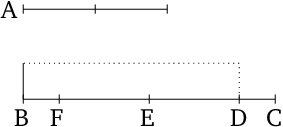If there are two unequal straight lines, and a (rectangle) equal to the fourth part of the (square) on the lesser, falling short by a square figure, is applied to the greater, and divides it into (parts which are) commensurable in length, then the square on the greater will be larger than (the square on) the lesser by the (square) on (some straight line) commensurable [in length] with the greater. And if the square on the greater is larger than (the square on) the lesser by the (square) on (some straight line) commensurable [in length] with the greater, and a (rectangle) equal to the fourth (part) of the (square) on the lesser, falling short by a square figure, is applied to the greater, then it divides it into (parts which are) commensurable in length.

This proposition states that if \[\alpha\,x-x^2=\frac{\beta^2}4,\] (where $\alpha=BC$, $x=DC$, and $\beta=A$), then \[\alpha\quad\text{ and }\quad\sqrt{\alpha^2-\beta^2}\] are commensurable when \[\alpha-x\quad\text{ and }\quad x\] are commensurable, and vice versa.
Proofs: 1
Proofs: 1 2 3 4 5 6 7 8 9 10 11